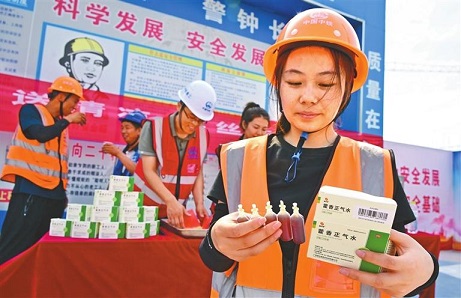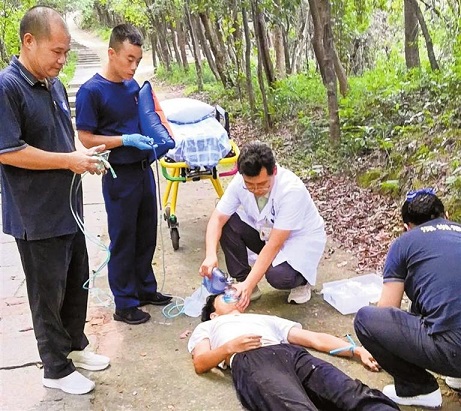Shenzhen
 2024/7/30
2024/7/30
 source: Shenzhen Daily
source: Shenzhen Daily
 Print
Print

A construction worker receives heatstroke prevention medicine at a construction site in Qingdao, eastern China’s Shandong Province, in this file photo. Health experts advise avoiding outdoor activities during peak heat hours, particularly from 10 a.m. to 4 p.m., and to take protective measures when going outside. Xinhua

Emergency responders provide first aid to a 14-year-old boy suffering from heatstroke while hiking on Wutong Mountain in Luohu in Shenzhen. SD-Agencies
JeniZhang13@163.com
RECENT rainfall has brought a brief respite from the sweltering heat in Shenzhen, which saw the city’s heat alert raised from yellow to orange by the Shenzhen Meteorological Observatory last Thursday.
This marked Shenzhen’s first orange alert for excessively high temperatures this year, as temperatures soared above 35°C.
Since June, many regions across the country have issued high-temperature alerts, with some meteorological stations recording unprecedented heat for early June.
Since July 3, most areas in Shenzhen have been experiencing persistent high temperatures around 35°C. On July 7, it was reported that surface temperatures in certain areas of the city had exceeded 50°C, with ultraviolet radiation levels reaching a concerning intensity of level 4, indicating a high risk of exposure.
Following the country’s warmest recorded spring, Zheng Zhihai, the chief forecaster at the National Climate Center, warned that temperatures across most of China would likely remain higher than average this summer.
During periods of excessive heat, it’s crucial to stay cool, drink plenty of water, and take necessary precautions to guard against heatstroke, doctors advise.
Beat the heat
High temperatures are a common occurrence during the summer months. A day is classified as experiencing high-temperature weather when peak temperatures exceed 35°C, and multiple consecutive days of such heat constitute a heat wave.
China uses a three-tier warning system for high temperatures. Red represents the most severe warning, followed by orange and yellow.
A yellow alert signifies hot and humid conditions, indicating that the maximum daily temperature is expected to surpass 35°C for three consecutive days. An orange alert signifies intense heat, meaning the highest temperature in a 24-hour period will likely exceed 37°C. Finally, a red alert denotes extreme heat, typically indicating temperatures will rise above 40°C within 24 hours.
When temperatures reach 35°C and humidity exceeds 60%, the risk of heatstroke becomes significant. The danger escalates when temperatures exceed 37°C with humidity above 80%. These excessively high temperatures can disrupt the human body’s ability to regulate temperature, causing an alarming buildup of heat within the body that may damage the nervous system and organs. In severe cases, symptoms such as a persistently high body temperature, rapid breathing, and elevated heart rate can occur, which can be life threatening.
Health experts advise avoiding outdoor activities during peak heat hours, particularly from 10 a.m. to 4 p.m., and to take protective measures when going outside. Vulnerable groups, including children and the elderly, need to take additional safety measures. Workers in high-temperature settings should also adopt appropriate precautions.
Staying hydrated is essential. It is crucial to drink water regularly rather than waiting until you feel thirsty, especially when sweating significantly.
Li Mengli, a doctor from Shenzhen Hospital of the Guangzhou University of Chinese Medicine, emphasized the critical nature of the first 30 minutes after the onset of heat-related illness.
“Rapid cooling is vital. The golden half-hour period is the most important in terms of a heatstroke, during which one’s body temperature should be lowered,” Li said.
Once early symptoms of heatstroke develop, such as dizziness, nausea, and chest tightness, it is best to rest and drink cold water to cool down, according to Li.
Steps such as artificial heat dissipation, applying cold compresses, using ice packs under the armpits, and wiping with alcohol can be employed to mitigate heat-related issues.
If the condition is severe, the patient should seek medical treatment immediately.
Tips for hikers
Emergencies including heatstroke, foot sprains, and falls are the most common incidents that the Shenzhen Emergency Medical Center has handled since June this year. Data show that from July 3 to 12, ambulances were sent to Wutong Mountain 13 times to aid patients in distress.
One such incident occurred July 9, when a 14-year-old boy was found unconscious by the roadside near the Yunshen service station on Wutong Mountain. The ambulance team, from the Yantian District People’s Hospital, that responded to the call had to traversed the rugged terrain to reach the boy.
The team diagnosed the boy with severe heatstroke and administered emergency treatment before rushing him to the hospital. The boy’s condition was critical upon admission.
The center has issued several safety guidelines for hiking during the summer months. Climbers are advised to travel in groups rather than alone, especially on routes known for their intensity. Hikers are also advised to use main paths instead of less frequented or unfamiliar ones. Minors should always be accompanied by parents to ensure their safety.





